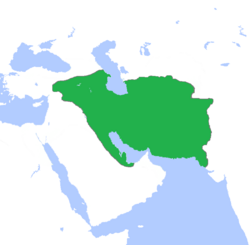اشکانیلر
اشکانیلر | |||||||||||||
|---|---|---|---|---|---|---|---|---|---|---|---|---|---|
| ۲۴۷ میلاددان قاباق–۲۲۴ میلاددان سوْنرا | |||||||||||||
 اشکانیلرین ان بؤیوک حدی | |||||||||||||
| پایتخت | تیسفون،[۱] هگمتانه، صددروازه، شوش، نسا، ارشاک | ||||||||||||
| عۆموُمی دیللر | یونانجا ,[۲] پارت دیلی، پارسی دیلی، آرامی دیلی ,[۳][۲] اکدی[۱] | ||||||||||||
| دین | مزدیسنا بابیل دینی[۴] | ||||||||||||
| دؤولت | فئودال شاهلیق[۵] | ||||||||||||
| ایران شاهلاری | |||||||||||||
• ۲۴۷–۲۱۱ میلاددان اؤنجه | بیرینجی اشک | ||||||||||||
• ۲۰۸–۲۲۴ میلاددان سوْنرا | بشینجی اردو | ||||||||||||
| قانون اوقانی | مهیستان مجلیسی | ||||||||||||
| تاریخی دؤنم | |||||||||||||
• یارادیلدی | ۲۴۷ میلاددان قاباق | ||||||||||||
• ییخیلدی | ۲۲۴ میلاددان سوْنرا | ||||||||||||
| |||||||||||||
اشکانیلر(۲۴۷ پ. م. ۲۲۴ م) و یا پارت امپراتورلوغو ایرانین بیر ایمپیراتورلوغو. اشک بوْ امپراتورلوغو یارادانین آدی ایمیش.[۶]بۇ ایمپیراتورلوق ۳ یۆزایل میلاددان اؤنجه ایرانین قوزئین باتیسیندا یاراندی.[۷]
اشکانیلر مدنیتی
اشکانیلر دؤولتینده شهر مدنیتی، صنعتکارلیق و تیجارت اینکیشاف ائدیب. ایپک یولونون اۆزرینده یئرلشهن اشکانیلر دۆنیا تیجارتینده موهوم واسطهچی رول اوینامیشدیر. اشکانیلر اؤز اراضیلریندن کئچهن کاروانلارین قورونماسینا خصوصی فیکیر وئریر، لاکین چین تاجیرلرینه روم ایله بیرباشا علاقه ساخلاماغا ایجازه وئرمیردیلر. اشکانیلرنین مدنیتینه یونان مدنیتینین گۆجلو تأثیری اوْلموشدور. بونو اشکانیلر پوللارینین عومومدونیا صحیّه تشکیلاتینینوندهکی یونان یازیلاری دا ثبوت ائدیر. اشکانیلر دؤولتینین آذربایجانین آتروپاتنا و آلبانی دؤولتلری ایله ده سیاسی ایقتیصادی علاقهلری اوْلموشدو.
قایناقلار
- ^ ۱٫۰ ۱٫۱ Fattah, Hala Mundhir (2009). A Brief History Of Iraq. Infobase Publishing. p. 46. ISBN 978-0-8160-5767-2.
One characteristic of the Parthians that the kings themselves maintained was their nomadic urge. The kings built or occupied numerous cities as their capitals, the most important being Ctesiphon on the Tigris River, which they built from the ancient town of Opis.
- ^ ۲٫۰ ۲٫۱ Green 1992, səh. 45
- ^ Chyet, Michael L. (1997). Afsaruddin, Asma; Krotkoff, Georg; Zahniser, A. H. Mathias (eds.). Humanism, Culture, and Language in the Near East: Studies in Honor of Georg Krotkoff. Eisenbrauns. p. 284. ISBN 978-1-57506-020-0.
In the Middle Persian period (Parthian and Sassanid Empires), Aramaic was the medium of everyday writing, and it provided scripts for writing Middle Persian, Parthian, Sogdian, and Khwarezmian.
- ^ Brosius, Maria (2006). The Persians. Routledge. p. 125. ISBN 978-0-203-06815-1.
The Parthians and the peoples of the Parthian empire were polytheistic. Each ethnic group, each city, and each land or kingdom was able to adhere to its own gods, their respective cults and religious rituals. In Babylon the city-god Marduk continued to be the main deity alongside the goddesses Ishtar and Nanai, while Hatra's main god, the sun-god Shamash, was revered alongside a multiplicity of other gods.
- ^ Sheldon 2010, p. 231
- ^ Brosius 2006, səh. 84
- ^ "roughly western Khurasan" Bickerman 1983, səh. 6.
